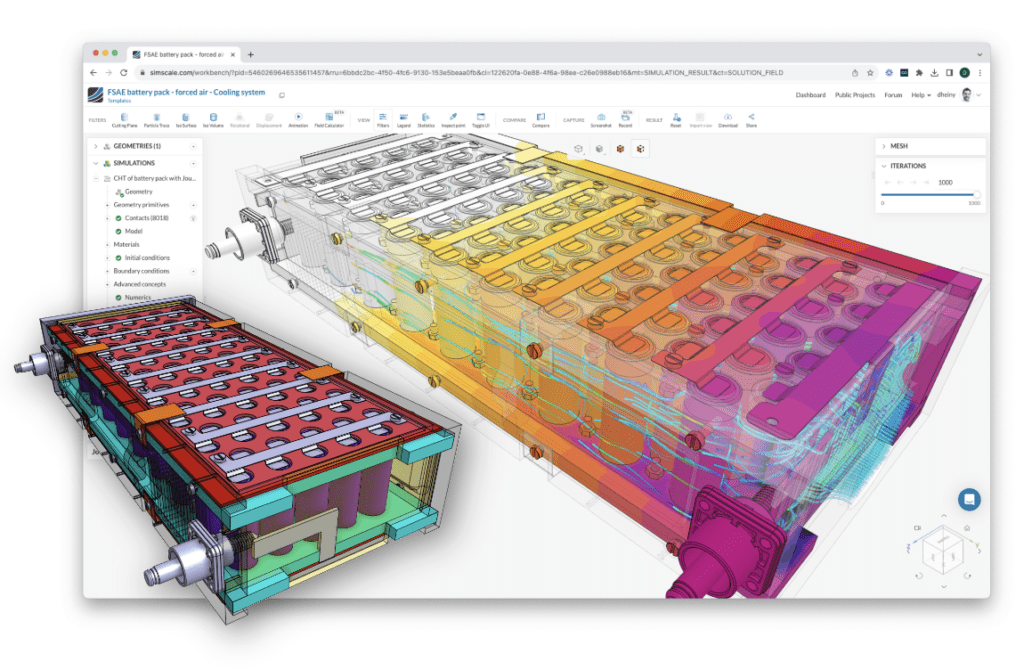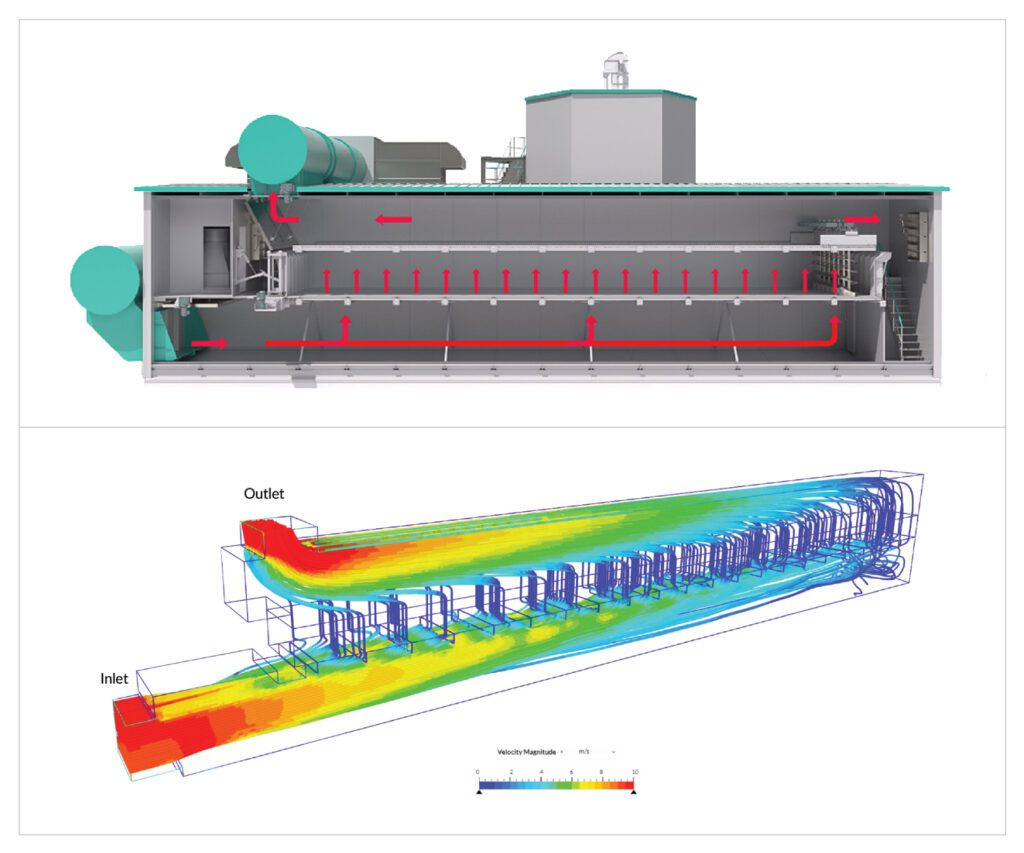Engineering challenges are growing more complex as industries demand higher efficiency, precision, and innovation. To meet these demands, engineers need tools that can accurately predict how their designs will perform under real-world conditions. This is where physics simulation becomes essential.
Physics simulation allows engineers to model physical forces, interactions, and behavior digitally. Instead of relying solely on physical prototypes, simulations provide insights faster and at a lower cost. Effective physics modeling software empowers engineers to analyze and optimize designs across multiple domains.
This guide explores physics simulation, its diverse applications, and how SimScale, a cloud-native platform, stands out as a versatile and collaborative physics modeling tool.
What is Physics Simulation and Physics Modeling Software?
Physics simulation is the process of modeling and analyzing how physical systems behave under various conditions. It uses numerical methods to predict responses like fluid flow, thermal distribution, structural deformation, and electromagnetic fields.
Physics modeling software enables engineers to create, run, and analyze these simulations. It provides a digital environment where users define geometries, apply physical parameters, and visualize results.
Key Features of Effective Physics Modeling Software
- Multiphysics Capabilities: The ability to combine different types of physics (e.g., thermal, structural, and fluid) within a single simulation to capture complex interactions.
- Flexibility: Support for user-defined physics parameters, allowing engineers to tailor simulations to specific challenges.
- Ease of Use: Intuitive interfaces and streamlined workflows make advanced simulations accessible, even for those without deep simulation expertise. This focus on user experience helps teams adopt simulation more effectively, leading to better project outcomes.
- Real-time Collaboration: SimScale’s cloud-native platform enables teams to share simulation results effortlessly. Design engineers, manufacturing teams, and testing departments can access the latest simulation data in real time, ensuring everyone stays aligned.
- Workflow Efficiency: Integrating simulations into the design process reduces development time. Instead of waiting for physical prototypes, engineers can make real-time adjustments based on simulation insights, accelerating decision-making.
SimScale integrates these features, providing a unified platform where engineers can model complex physical systems, simulate multiple physics domains, and collaborate effectively to achieve precise and actionable insights. By leveraging SimScale, teams can seamlessly bridge the gap between design and simulation, ensuring higher productivity and innovation.
Diverse Engineering Applications of Physics Simulation
SimScale supports a wide range of engineering applications, making it an indispensable tool across various industries, including automotive, industrial equipment, electronics manufacturing, and Architecture, Engineering, and Construction (AEC). By enabling simulations for complex physical systems, SimScale helps engineers address challenges in design, optimization, and testing more efficiently. Below is an overview of the physics available in SimScale and how to leverage them in key domains:
1. Structural Mechanics
Structural analysis simulations assess how components handle stresses, loads, and deformations. Engineers use these simulations to ensure designs meet safety and performance standards.
One example of structural analysis using cloud-native simulation is validating the load-bearing capacity of industrial machinery frames. This ensures designs meet safety standards and comply with regulatory requirements, reducing the risk of costly failures in real-world applications.
2. Fluid Flow (CFD)
Computational Fluid Dynamics (CFD) models how gases and liquids flow through and around objects. CFD simulations help engineers improve efficiency and performance in fluid-related systems.
For instance, HVAC simulations are essential for engineers looking to optimize airflow and temperature distribution in buildings. By using CFD, engineers can design systems that enhance energy efficiency while maintaining occupant comfort.
3. Heat Transfer
Heat transfer simulations model the distribution of heat within systems, helping engineers design effective cooling or heating solutions.
Thermal simulations are particularly valuable for improving battery thermal management. By modeling thermal distribution, engineers can prevent overheating and enhance the lifespan of electric vehicle batteries, ensuring both performance and safety.

4. Electromagnetics
Electromagnetic simulations predict how electric and magnetic fields interact with components. These simulations are crucial for optimizing electrical devices and minimizing interference.
For example, electromagnetic simulations can help optimize the design of electric motors by modeling the interactions of electric and magnetic fields. This enables engineers to identify inefficiencies, reduce energy losses, and enhance motor performance, ensuring reliable operation and cost savings in the long term.
5. NVH (Noise, Vibration, and Harshness) Simulation
NVH simulations evaluate and minimize noise and vibration in mechanical systems. This is especially valuable for automotive engineers seeking to enhance vehicle comfort (user experience) and product quality. For example, by modeling and reducing cabin noise and vibrations, engineers can create smoother and quieter rides, enhancing the overall driving experience for passengers.
SimScale supports all these applications in a single cloud-native platform, making it easier for engineers to switch between different types of simulations seamlessly.
The Role of Physics Simulation in Optimizing Designs
By leveraging the power of the cloud with SimScale, engineers can efficiently identify design flaws early in the development process, significantly reducing the need for physical prototypes. The platform’s ability to explore multiple design variations quickly not only accelerates development cycles but also lowers associated costs and enhances precision and accuracy.
Additionally, the flexibility of SimScale’s user-defined physics capabilities provides engineers with customization capabilities, enabling them to adapt simulations to address unique and specialized challenges and ensure results remain accurate and highly relevant to the problem at hand.
Case Study: Bühler Group
Bühler, a global leader in industrial equipment, leveraged SimScale’s cloud-native simulation to revolutionize their design process. By deploying early-stage simulations across 25 departments, over 100 engineers were able to run simulations online and on demand without capacity limitations. This approach enabled faster design convergence and reduced reliance on physical prototypes, saving both time and costs.

SimScale allowed Bühler to evaluate 60 design variants in just two weeks, a feat that previously required far more time and resources. This rapid iteration capability not only accelerated innovation but also supported bottom-line savings by eliminating the need for expensive hardware and traditional simulation tools. By streamlining workflows and enhancing collaboration across globally distributed teams, Bühler could achieve greater operational efficiency and bring products to market faster. Read more about Bühler’s success here.
“Integrating simulation early in the product development process allows one to better understand the physics and gain confidence in design choices. With SimScale, every design engineer has access to simulation.”

Clément Zémerli Senior Simulation Engineer in Corporate Technology at Bühler
Advanced Model Management Capabilities
SimScale’s advanced model management tools provide engineers with the capabilities to organize, track, and collaborate on their simulation projects seamlessly. These features are designed to enhance productivity, streamline workflows, and ensure precision throughout the simulation process.
SimScale’s model management capabilities stand out by providing:
- Version Control: Engineers can manage and track multiple iterations of their simulations, ensuring no critical updates are lost, and previous iterations remain accessible.
- Collaboration Tools: Customizable user permissions allow teams to collaborate securely, ensuring data integrity even with multiple contributors.
- Search and Organization: Engineers benefit from features such as tags, filters, and efficient search functions, enabling them to organize and locate simulation files with ease.
- Cloud-Native Integration: All model data is stored securely in the cloud, making it accessible from any location and removing the need for specialized hardware setups.
- AI-Powered Simulation Insights: SimScale leverages artificial intelligence to analyze simulation data, offering engineers predictive insights and optimization suggestions. This feature accelerates decision-making by identifying potential performance improvements or design flaws early in the process.
These tools empower engineers to streamline project workflows and make informed decisions efficiently.
Guided Simulation Workflows for Efficient Modeling
SimScale’s guided simulation workflows allow simulation experts to create templates and standardized processes. These workflows ensure consistency and help non-experts perform reliable simulations.
Step-by-Step Process
- Import your CAD file into a SimScale template.
- Adjust simulation parameters based on your company design guide.
- Run the simulation in the cloud and get instant, standardized results.
- Access, track, and share your results in SimScale from anywhere and with any team member.
- Sync your results with your PLM system for seamless integration into your workflow.
Benefits of Guided Templates
- Efficiency: Standardized workflows reduce setup time.
- Accuracy: Templates ensure simulations are performed correctly.
- Collaboration: Teams can follow established processes, enhancing teamwork.
More about SimScale’s guided simulation workflows here.

The Power of Multiphysics Simulation in SimScale
SimScale’s Multiphysics simulation in the cloud allows engineers to model multiple physical phenomena in a single comprehensive analysis. This provides a more accurate representation of real-world behavior.
It also enables flexibility and a seamless combination of analyses, all in a single workbench. SimScale’s “One Platform, Broad Physics” approach enables engineers to combine different physics types, such as thermal, structural, electromagnetic, and fluid simulations, to analyze complex interactions within a design.
Here are some real-world examples:
- EV Motor Development: Analyze heat, stress, magnetic flux, and fluid interactions to optimize motor performance.
- Battery Thermal Management: Ensure efficient cooling in battery packs to prevent overheating.
- Fluid Flow Optimization: Improve industrial processes by modeling fluid dynamics accurately.
Give SimScale a Try?
Physics simulation enables engineers to overcome design challenges with precision and speed, making it an indispensable tool in modern engineering. By providing access to multiphysics analysis, guided workflows, and real-time collaboration, SimScale ensures engineers can streamline their processes and achieve optimized designs faster and more effectively.
Explore SimScale’s comprehensive resources for more information, or start simulating today by clicking the button below.





